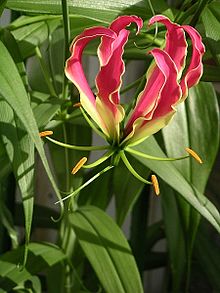- Gloriosa (genus)
-
Gloriosa 
Gloriosa superba Scientific classification Kingdom: Plantae (unranked): Angiosperms (unranked): Monocots Order: Liliales Family: Colchicaceae Genus: Gloriosa
L.Species See text.
Gloriosa is a genus of five or six species in the plant family Colchicaceae, from tropical Africa and Asia. The most common English names are flame lily, fire lily, gloriosa lily, glory lily, superb lily, climbing lily, and creeping lily. They are tender, tuberous rooted deciduous perennials, adapted to summer rainfall with a dormant dry season. Their native range is Africa, Southeastern Asia and parts of Malaysia, but they are now widely cultivated.[1] All parts of the plant contain colchicine and related alkaloids and are therefore dangerously toxic if ingested, especially the tubers; contact with the stems and leaves can cause skin irritation.
Various preparations of the plant are used in traditional medicines for a variety of complaints in both Africa and India.
Gloriosa superba is the national flower of Zimbabwe (where it is a protected plant). It is also the state flower of Tamil Nadu state in India, and was the national flower of Tamil Eelam, and as such was displayed during Maaveerar Day.
Contents
Botany
Gloriosa are perennial herbs that climb or scramble over other plants with the aid of tendrils at the ends of their leaves and can reach 3 meters in height. They have showy flowers, distinctive because of their pronouncedly reflexed petals, like a Turk’s cap lily, ranging in colour from a greenish-yellow through yellow, orange, red and sometimes even a deep pinkish-red.
Some synonyms, arising from the many variations, for Gloriosa superba include G. rothschildiana (or G. superba ‘Rothschildiana’), G. simplex, G. virescens, G. abyssinica, G. carsonii, G. minor, G. lutea, G. baudii.
Genus description
"Scandent herbs, the rootstock a horizontal rhizome, the stem leafy, the leaves spirally arranged or subopposite, the upper ones with cirrhose tips; flowers solitary, large, borne on long, spreading pedicels, actinomorphic, hermaphrodite; perianth segments 6, free, lanceolate, keeled within at base, long-persistent; stamens 6, hypogynous, the anthers extrorse, medifixed and versatile, opening by longitudinal slits; ovary superior, 3-celled, the carpels cohering only by their inner margins, the ovules numerous, the style deflected at base and projecting from the flower more or less horizontally; fruit a loculicidal capsule with many seeds"[1]
Species
- G. flavovirens
- G. superba
- G. grandiflora
- G. lindeni
- G. littonioides
- G. revoilii
- G. rigidifolia
G. superba description
A "scandent plant, climbing by leaftip tendrils. The perianth segments, which are accrescent during anthesis and become reflexed, are striking in color, yellow proximally and at margins and dark red in the median portion".[1]
Habitat/ecology
In Australia, "scattered naturalized populations exist in the understorey of coastal dry sclerophyll forest and sand dune vegetation throughout south-east Queensland and New South Wales".[2] It is considered a rampant and dangerous invasive weed in Australia, dominating the coastal dunes at the expense of native species and leading to deaths of native animals and birds when ingested.
In India,Gloriosa is distributed in the Western Ghats but the density is rapidly decreasing due to excessive uprooting by the Herbal Medicine producers.Propagation
"Propagation generally occurs from seeds, although mature plants can be divided and grown from tubers. The hard seeds can remain dormant for 6-9 months."[2]
Toxicology
While all parts of the Gloriosa contain colchicine, the roots have the highest concentration of the toxin. One-tenth of an ounce of Gloriosa root can be fatal to an adult.[citation needed]
References
- ^ a b c Smith, Albert C. 1979. Flora Vitiensis nova: A new flora of Fiji (Spermatophytes only). Pacific Tropical Botanical Garden, Lawai, Kauai, Hawaii. 1:141-142 in Biodiversity Heritage Library
- ^ a b Csurhes, S., Edwards, R. 1998. Potential environmental weeds in Australia: Candidate species for preventative control. Biodiversity Group, Environment Australia, Canberra. pp. 164-165 pdf
External links
Categories:- Colchicaceae
- Liliales genera
- National symbols of Zimbabwe
- Flora of India
- Flora of Sri Lanka
Wikimedia Foundation. 2010.
